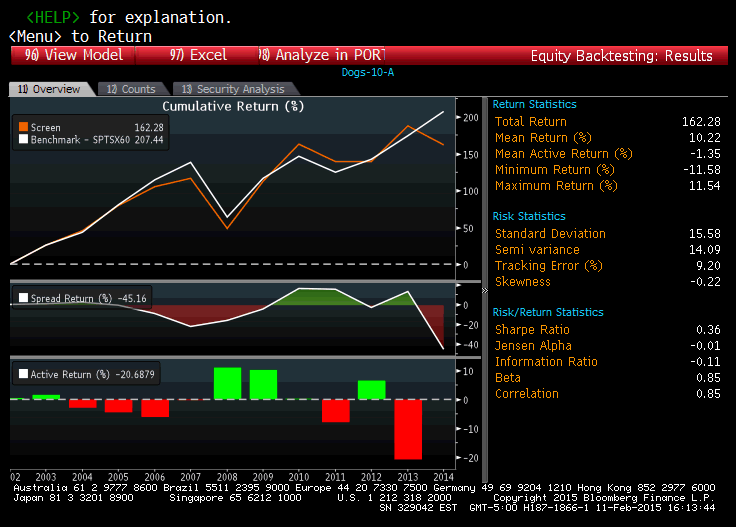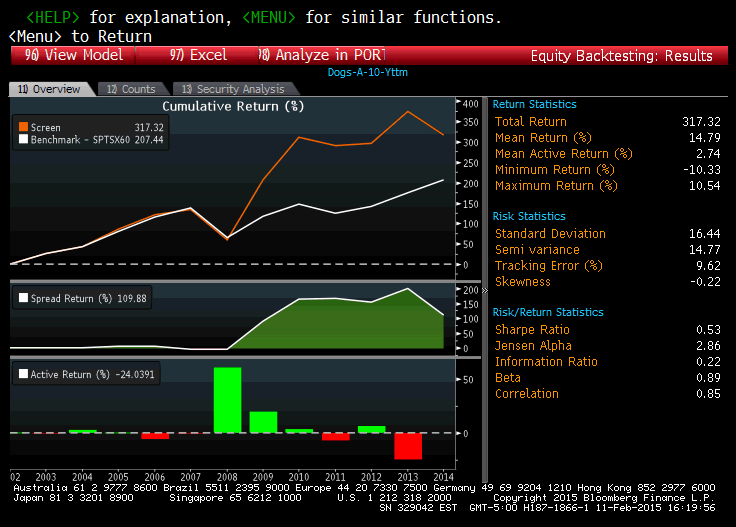Testing the Dogs of the TSX
While the basic Dogs strategy is simple, results can vary depending on how you measure success
Advertisement
While the basic Dogs strategy is simple, results can vary depending on how you measure success

 (In each case the tests used 12 years worth of data, ending Dec. 31, 2014, with equally-weighted portfolios and annual rebalancing.)
The indicated yield method largely followed the index over the period, but lagged in recent times. On the other hand, investors using the trailing yield handily beat the index over the whole period.
A good part of the return difference was attributable to stocks, like Teck, that were purchased in bad times and then recovered.
For instance, Teck climbed from $6.02 per share at the end of 2008 to a whopping $36.82 per share in only 12 months. It gained 512% in 2009 and, as a result, pushed the trailing-yield portfolio up significantly.
Problem is, it wasn’t clear—at the time—that Teck would survive. If history played out differently, the company might have been a big disappointment for Canadian dividend investors. (Much like Laidlaw and Yellow Media.)
I hasten to add that, while the back tests are interesting, they only cover a short time period, which makes them far from definitive.
As a result, the winning variant will only truly become apparent in the fullness of time.
(In each case the tests used 12 years worth of data, ending Dec. 31, 2014, with equally-weighted portfolios and annual rebalancing.)
The indicated yield method largely followed the index over the period, but lagged in recent times. On the other hand, investors using the trailing yield handily beat the index over the whole period.
A good part of the return difference was attributable to stocks, like Teck, that were purchased in bad times and then recovered.
For instance, Teck climbed from $6.02 per share at the end of 2008 to a whopping $36.82 per share in only 12 months. It gained 512% in 2009 and, as a result, pushed the trailing-yield portfolio up significantly.
Problem is, it wasn’t clear—at the time—that Teck would survive. If history played out differently, the company might have been a big disappointment for Canadian dividend investors. (Much like Laidlaw and Yellow Media.)
I hasten to add that, while the back tests are interesting, they only cover a short time period, which makes them far from definitive.
As a result, the winning variant will only truly become apparent in the fullness of time.
| Name | Price | P/B | P/E | Earnings Yield | Dividend Yield |
|---|---|---|---|---|---|
| BCE (BCE) | $55.77 | 4.28 | 18.71 | 5.34% | 4.66% |
| CIBC (CM) | $94.40 | 2.13 | 12.01 | 8.33% | 4.36% |
| Rogers (RCI.B) | $45.09 | 4.23 | 17.28 | 5.79% | 4.26% |
| National Bank (NA) | $47.65 | 1.85 | 10.93 | 9.15% | 4.20% |
| Husky Energy (HSE) | $28.69 | 1.41 | 22.77 | 4.39% | 4.18% |
| Potash Corp (POT) | $46.26 | 3.76 | 22.88 | 4.37% | 4.11% |
| Bank of Montreal (BMO) | $78.50 | 1.63 | 12.19 | 8.20% | 4.08% |
| Shaw (SJR.B) | $29.75 | 3.01 | 16.62 | 6.02% | 3.98% |
| Bank of Nova Scotia (BNS) | $66.52 | 1.8 | 11.69 | 8.55% | 3.97% |
| Royal Bank of Canada (RY) | $77.42 | 2.3 | 12.86 | 7.78% | 3.87% |
Share this article Share on Facebook Share on Twitter Share on Linkedin Share on Reddit Share on Email